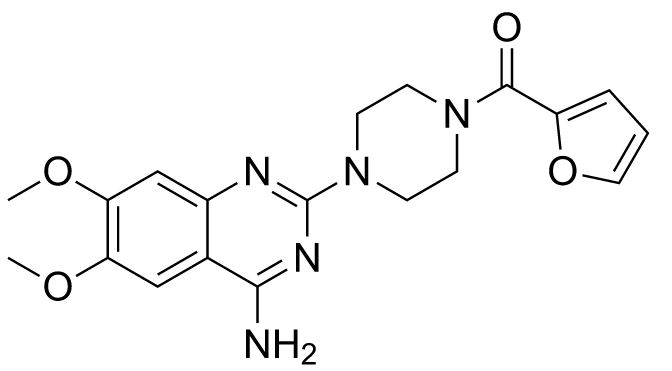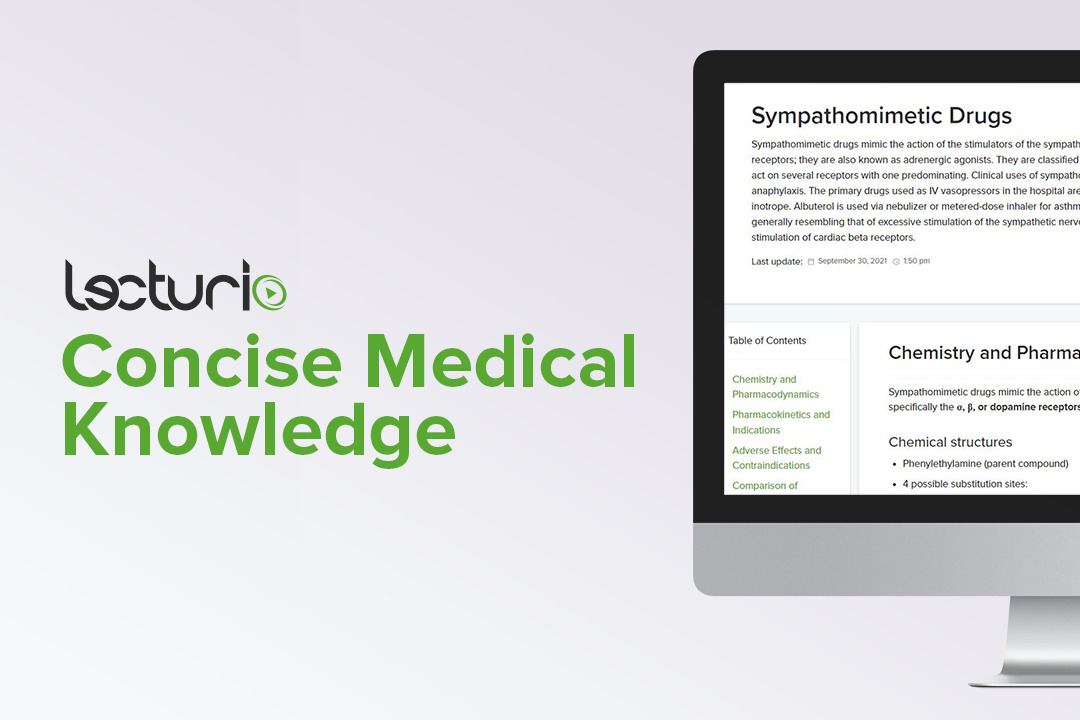Playlist
Show Playlist
Hide Playlist
Sympathomimetic Effects
-
Slides Sympathomimetic Acivators and Effects ANS Pharmacology.pdf
-
Download Lecture Overview
00:01 Okay. Let's go back to the eye. So what are the effects of drugs that are sympathomimetics on the eye? Well, first of all, you get contraction of the radial or dilator muscles, so you open up the iris. 00:17 That's called mydriasis. Now, accommodation is rarely affected in this situation. 00:23 But just remember that when you're running away from that saber-toothed tiger as a caveman or a cavewoman, you want to be able to see in the dark. That's a sympathomimetic effect, and so sympathomimetic drugs are going to cause pupillary dilatation. 00:39 Nonselective alpha agonists reduce intraocular pressure, and that's because you increase drainage of aqueous humour. 00:49 Alpha 2 selective agonist also reduce intraocular pressure, and that's because there's reduced synthesis of aqueous humour, and examples are listed here. Okay, now I'm confused. What is going on? And I know you're saying this "You just finished telling me that those other drugs, the cholinomimetics do the same thing. 01:15 and the beta blocker do the same thing. Well, how come all of these drugs reduce intraocular pressure?" Well, let's just go over it really quickly. Beta blockers reduce secretion from the ciliary epithelium. 01:28 Cholinomimetics contract the ciliary muscles and they open up trabecular. So, normally the trabecular are closed, but as the ciliary muscle contracts, they open up like this. And what you end up having is increased outflow of the aqueous humour, and therefore you reduced pressure. Alpha agonists increased outflow through the veins. 01:55 So, in the veins in the back of the eye and inside the retina, you have veins that are sealed up with tight gap junctions, and when the veins relax because of the alpha agonists, the gap junction open up, fluid from the eye can get absorbed into the vein, and so the vein carries away the extra pressure. 02:16 Alpha 2 agonists decrease aqueous secretion from other parts of the eye. 02:21 Prostaglandins like latanoprost increase aqueous outflow through another mechanism which we won't get into, and you don't need to know right now. And carbonic anhydrase inhibitors decrease aqueous secretion due to decreased bicarbonate ion. So, remember you need bicarbonate ion to make aqueous humour or aqueous fluid. 02:46 Therefore, if you have less bicarbonate because of the carbonic anhydrase inhibitor, you'll have less ability to make more fluid. So, all of these different drug classes reduce intraocular pressure. 03:02 So, when you're going through your exam, just remember that pretty much all of the drugs that are eyedrops are going to reduce intraocular pressure, and the only drug that increase intraocular pressure are generally systemic drugs. 03:20 Let's move on. Sympathomimetic effects on the heart are usually mediated through drugs like isoproterenol and epinephrine. 03:29 We actually use these drugs a lot in the intensive care unit. They cause sinoatrial node excitation. 03:35 They increase the rate of the heart, and we remember call that positive chronotropy. 03:40 They also increase contractile force in the atria. So you have positive inotropy in the atria. 03:47 In the AV node, you increased conduction velocity. Do you remember what that's called? That's positive dromotropy. 03:54 Increased refractory period as well. With the ventricles, you increased the contractile force of the ventricles, we of course call that positive inotropy or more strength. 04:06 With norepinephrine, we do have a bit of a comeback in the use of norepinephrine in heart failure treatment, it is a positive inotrope as well. 04:17 Isoproterenol is a nonselective agent. And one of the effects that you will see in the vasculature is that it will reduce arteriolar tone, but it also increases cardiac output. So, the net effect is generally a reduced blood pressure and an increased heart rate. So sometimes, when a patient has poor forward heart function, we will give isopro. 04:43 Okay, dopamine. Dopamine is a complicated drug, but we still use it in the intensive care unit as one of the inotropes. 04:50 At low dose, you cause vasoconstriction of the splanchnic bed. What does that mean? That means that less blood flow is going to the gut. And then a person who is septic, we need to raise the blood pressure. 05:03 So, blood flow to the gut is a waste of time as far as an intensive care doctor is concern, so we want to increase the blood pressure by redirecting blood flow away from the gut. 05:14 So that's how we increase blood pressure with dopamine at low dose. 05:18 Now, in the ICU, if I find that my renal perfusion or my blood flow through the kidneys is reduced, I will use dopamine. So it's one of the tricks that we have. And remember, from a previous lecture, kidneys are flow-dependent organs, so we have to maintain flow through that kidney. 05:39 What about at higher doses? At higher doses, it stimulates beta receptors. 05:45 So, you can increase cardiac output pass a certain dose. 05:49 At very high dose, what we could arguably call a toxic dose, it stimulates alpha receptors. 05:57 So, that's when you start to see increase peripheral resistance. When would you ever use a high dose dopamine drip? And I'll tell you a story about a young lady, she was 24, she was in my intensive care unit, and she was dying. 06:12 In fact, the night doctor that had been working before me, had essentially given up, because all of the inotropes were at maximum dose, all of the support system and MAST garments were at maximum therapy, and this patient still had pressure in the 60s from severe sepsis. I knew what the organism was, the antibiotics were right, everything else was right, but she just wasn't responding. 06:36 At that point, I said to the patient family. Look, this is where we need to break the rules. 06:42 If we increase the dose of the dopamine, there is going to be a risk of digital ischemia and she may lose fingers throughout treatment. We decided to go ahead with that kind of aggressive inotropic therapy, and low and behold, we brought the blood pressure up, we were able to maintain pressures long enough until the antibiotics finally kicked in and started doing their jobs, and eventually we were able to titrate off all of the inotropes, and she survived, all fingers intact. So there is a role for dopamine at that super high dosage. 07:14 I tell you this story, not to you know, pat myself on the back, but so that you realize that we can definitely use high doses in very isolated circumstances. And if you understand how drugs work, you can sometimes use things in super normal doses to save lives. 07:30 There are other places where we use sympathomimetic drugs. In chronic orthostatic hypotension. 07:37 There are a lot of patients out there that when they stand up, they drop their pressures through their boots. 07:43 Now, I have several patients over the age of 100, and many patients over the age of 90, and I often see this in my very elderly patients. They just drop their pressure when they stand up, but when they're sitting or lying, their pressures were normal. We sometimes use ephedrine, which is a nonselective alpha agonist in these patients. 08:04 We can also sometimes use a newer drug called midodrine, which is an alpha 1 agonist as well. 08:12 Okay. What are the sympathomimetic effects on the brain? Now, remember that catecholamines generally don't cross the blood brain barrier. Why? Because they are polar molecules. 08:23 However, cocaine and amphetamines do cross the blood brain barrier. There is a mild increased in alertness and reduction of fatigue at very low doses of these drugs. At toxic levels, particularly with cocaine, you have anorexia, aggressiveness, some paranoia, and sometimes seizures. 08:43 Amphetamines may also be used in central nervous system sympathomimetic activity to treat narcolepsy. 08:52 Methylphenidate is a new drug that we use in atention deficit hyperactivity disorder, that also is quite useful and it is a sympathomimetic. 09:03 What about the lung? What can we do with the lung? Sympathomimetic effects in the lung relaxes in response to beta 2 agonists. So, isoproterenol, albuterol, salbutamol, formoterol, all of these drugs, the one I want you to remember in particular is salbutamol which is also known as ventalin. 09:23 Now, sometimes I'll use epinephrine, that's usually in anaphylatic shock, and we often will give epinephrine subQ, so you'll probably aware of EpiPens that kids will carry, in the allergy kids, particularly if they're allergic to peanuts. 09:43 What are the sympathomimetic effects in the gut? So, the smooth muscle will relax its muscle. 09:49 And this is both an alpha and a beta mediated event. Now, alpha 2 receptors may also decrease the amount of salt and water secretion in the gut as well. 10:03 What about the urinary tract? Now, this is something that I've always found difficult to understand, so let's just think about running away from our saber-toothed tiger. If you're running away from a saber-toothed tiger, do you really want to be peeing? Well, the answer is no. You don't want that saber-toothed tiger to pick up your scent, from your urine, right? So, it makes sense that the system is going to shut down the excretion of urine. 10:30 So, the detrusor muscle will relax, the trigone will contract, the sphincter will contract. 10:38 Now, sometimes you can use ephedrine in urinary incontinence and enuresis, but in general, we're talking sympathomimetic effects are going to reduce the urination drive. 10:52 What are its effects on the female genital tract? Beta 2 agonists can cause uterine relaxation. 10:59 This will cause a secondary tachycardia in the mother. In general, we don't want to use this drug unless it's absolutely necessary, but we do use ritodrine and terbutaline in premature labour to try and surpress contraction. 11:14 What about the effects on the prostate? This is usually an alpha 1 territory. 11:20 We use alpha 1 agonists to contract prostatic smooth muscle. 11:26 Ephedrine is sometimes used for urinary incontinence in this case.
About the Lecture
The lecture Sympathomimetic Effects by Pravin Shukle, MD is from the course ANS - Pharmacology.
Included Quiz Questions
What most likely decreases with isoproterenol administration?
- Refractory period of the atrioventricular node
- Positive chronotropic effect
- Positive ventricular inotropic effect
- Positive dromotropic effect
- Positive atrial inotropic effect
What drug class reduces intraocular pressure by reducing aqueous production?
- Beta blockers
- Cholinomimetics
- Non-selective alpha-adrenergic agonists
- Prostaglandins
- All of the answers reduce aqueous production.
What drug might improve symptoms of urinary incontinence?
- Ephedrine
- Tamsulosin
- Valium
- Neostigmine
- Bethanechol
Which receptors are primarily stimulated during tocolysis caused by terbutaline?
- Beta-2 adrenergic receptors
- Beta-1 adrenergic receptor
- Alpha-2 adrenergic receptor
- Dopamine receptor
- Alpha-1 adrenergic receptor
Customer reviews
5,0 of 5 stars
| 5 Stars |
|
1 |
| 4 Stars |
|
0 |
| 3 Stars |
|
0 |
| 2 Stars |
|
0 |
| 1 Star |
|
0 |
This was most helpful and extremely interesting. Hats off for explaining such a tough topic in an exceptionally innovative and engrossing manner.







